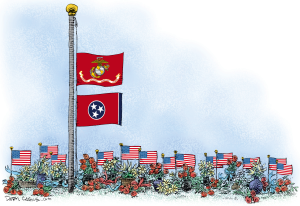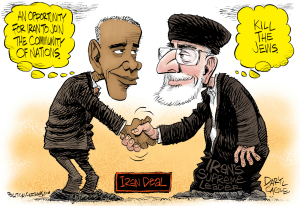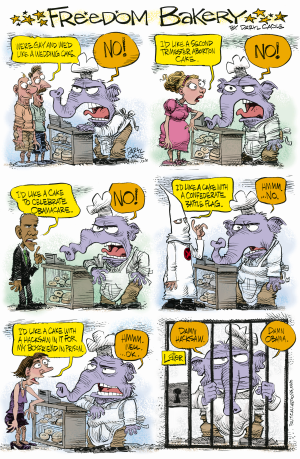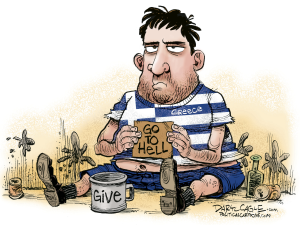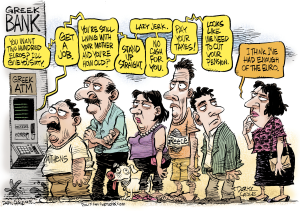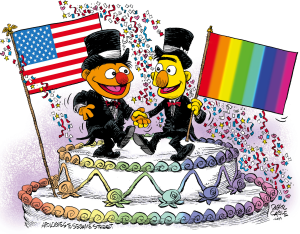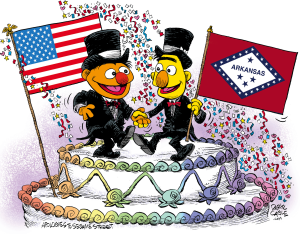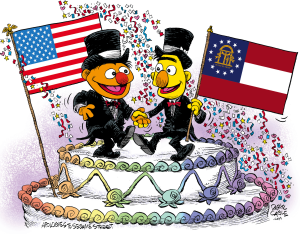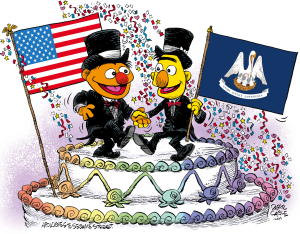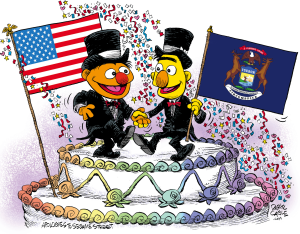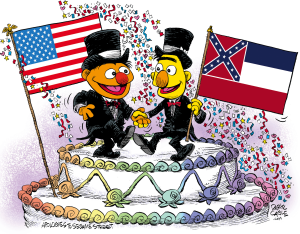
Beaten Press Bitch Version
Here are my last four cartoons. The most recent is below, on the press growing less cute and adorable for Obama. I think if I drew puppies in all of my editorial cartoons, my work would be much more popular. I didn’t quite know how I would handle this one when I started drawing, so the rough sketch is a bit of a mess.
I was thinking of making this a four panel cartoon at first, with the doggie growing progressively bigger and a caption, but the simple two panel format won out. here is the line art that most people will see in their newspapers that print in black and white.

And here is the color. Readers love the doggies.

I drew the cartoon below when Obama made his first statement about the IRS scandal. here’s the black and white most people see.

And here’s the color.

Before that I did this one on the ongoing, outrageous, sexual assault scandals in the military.

And I drew this “Energizer Bunny” cartoon about the Benghazi Scandal that the Republicans can’t bear to see fade away.

There was a time when I would see an Energizer Bunny cliche editorial cartoon every week. Alas, those were the good old days.
Obama and the Press Puppy

IRS Scandal and Obama

Benghazigizer Bunny

Libya Mountain Out of a Molehill
It is fascinating to watch Fox News’ team effort to promote the Libya attack as an Obama administration scandal just before the election – and their consternation that other media doesn’t share their passion. Here’s the cartoon I drew on the topic.

Our liberal cartoonist, Adam Zyglis drew this “mountain out of a molehill” cartoon …

And our conservative-team-player cartoonist, Eric Allie, responded to Adam with the cartoon below …

Even though I think the Libya “scandal” is right wing wishful thinking, I love the ‘toon tit for tat. See more Libya “scandal” cartoons here.
Stinky Solyndra

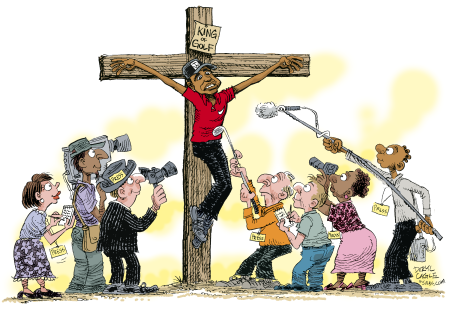
Apple: You Can Ridicule Obama, but Don’t Bash Tiger Woods
Should newspaper editorial cartoonists be banned from drawing cartoons about some selected, famous people? Many believe we should not be allowed to draw the Prophet Muhammad — but how about banning us from drawing Tiger Woods? If Apple has its way, iPhone users won’t see cartoonists commenting about Tiger, and other topics that might “ridicule public figures.”
I distribute my own cartoons and the work of dozens of other top editorial cartoonists from around the world to newspapers, Web sites and now to Apple’s iPhone and iPad. As the audience for news and opinion has grown on the iPhone, we’ve put more effort into developing editorial cartoon apps that show all the latest cartoons that the cartoonists draw on different topics. Apple approved our “msnbc.com Obama Cartoons” app that shows the latest newspaper editorial cartoons drawn about President Obama, but Apple rejected our app on the topic of Tiger Woods. It seems that Tiger crosses an editorial line at Apple.
Editorial cartoonists are simply columnists who write their opinions in the form of images, rather than only using words. Cartoons often have more impact than words. The editorial cartoon leaps out at the reader from the op-ed pages of newspapers. Readers cut cartoons out to stick on their refrigerators, but don’t do the same for those dull columns. Newspaper editorial cartoons have an important history in American journalism. Political cartoons are taught as required curriculum in high schools –- still, some people, like the editors at Apple, seem to see editorial cartoons as different than other forms of journalism — as a part of the newspaper that is somehow more offensive than words.
When I submitted my first iPhone app, “msnbc.com Cartoons,” the editors at Apple took three months to consider it, an unusually long time. I’m told it was a difficult decision for them. At that time they also rejected an app called “Bobble Rep” by my friend, Mad Magazine cartoonist Tom Richmond, because it contained caricatures of members of Congress; after some public outcry, Apple reconsidered and approved Tom’s app. Another cartoonist friend, Mark Fiore, had his rejected iPhone app reconsidered and approved only after he won a Pulitzer Prize for his cartoons. Soon after it was approved, Mark’s app became the number one best-selling news app on the iPhone. I’ve asked Apple to reconsider their rejection of our “Tiger Woods Cartoons” app, and have received no response.
With all of their rejections, Apple sends the cartoonist a form letter noting “content that ridicules public figures” is in violation of the iPhone license agreement.
Cartoonists love to chase the top news stories; some personalities, like Tiger Woods, are favorites of the editorial pages. From President Obama and Sarah Palin to Michael Vick and Michael Jackson, journalists debate about famous people in words while editorial cartoonists churn out the cartoons. It is the nature of a free and open debate that defines a democratic society.
Editorial cartoons are the best measure of the freedom of a nation. Cartoonists in Cuba have never drawn Fidel Castro; cartoonists in Egypt can’t draw their President Hosni Mubarak; cartoonists in China don’t draw their President Hu Jintao. Authoritarian regimes always turn first to control the cartoonists, and forbid them from “ridiculing public figures.”
As newspaper audiences decline, more readers have moved to the Web and now to mobile devices for news and opinion. The iPhone dominates the audience that consumes news on their phones, and the new iPad is designed to grab even more print readers, perhaps replacing print. Editorial cartoonists, who are moving from print and the Web to mobile devices, are finding that Apple’s views of their profession can have a profound impact on what their future audience will be.
I suppose Tiger Woods could be considered an unimportant topic for debate –- but newspaper editors certainly devoted a lot of space to Tiger; we heard about Tiger endlessly on television; columnists wrote about Tiger; editorial cartoonists drew hundreds of cartoons about Tiger — and Apple decided that Tiger Woods was not an appropriate topic of discussion for editorial cartoonists.
It is chilling to see Apple pick and choose which topics can be discussed in the media they control. By positioning itself to control the new methods of delivery for news and opinion, Apple assumes a special responsibility to allow for a full and free debate on all topics and personalities in the news.
I don’t want Apple deciding which public figures I may ridicule.
Daryl Cagle is a political cartoonist and blogger for MSNBC.com; he is a past president of the National Cartoonists Society. Daryl’s cartoons are syndicated to more than 850 newspapers, including the paper you are reading now. Daryl’s books “The BIG Book of Campaign 2008 Political Cartoons” and “The Best Political Cartoons of the Year, 2010 Edition” are available in bookstores now.
Below are some examples of cartoons that iPhone users will not see, from the “Tiger Woods Cartoons” app that Apple has rejected.
Catholic Church Crisis and Cartoon Circus

As the Vatican defends against lawsuits and launches a public relations blitz to defend the Pope, editorial cartoons may be the most visible, powerful and damning criticism the church faces. The cartoon floodgates have opened as editorial cartoonists around the world have released a deluge of Pope bashing cartoons.
By an odd coincidence, the Catholic Church has a strong presence in countries that happen to have a strong tradition of cartooning and the passionate anger of cartoonists who were raised in the church has been on display recently like never before.
Here is a selection of church scandal cartoons from around the globe.
Daryl Cagle is a political cartoonist and blogger for MSNBC.com; he is a past president of the National Cartoonists Society. Daryl’s cartoons are syndicated to more than 850 newspapers, including the paper you are reading now. Daryl’s books “The BIG Book of Campaign 2008 Political Cartoons” and “The Best Political Cartoons of the Year, 2010 Edition” are available in bookstores now.
Vitter and Craig



